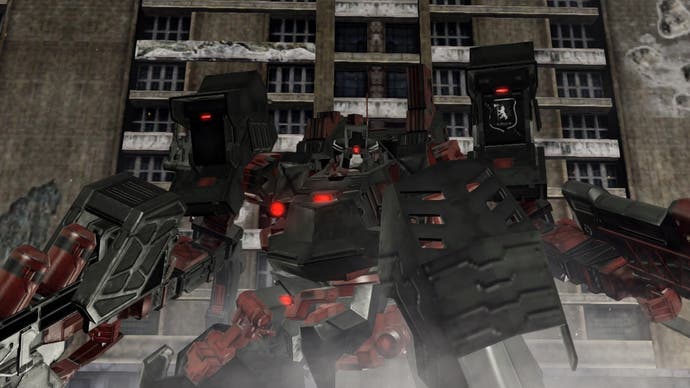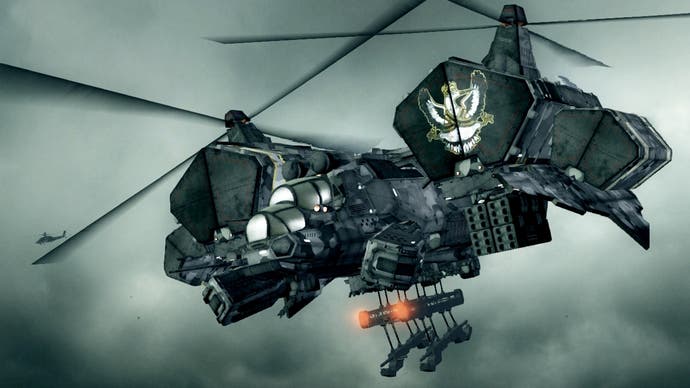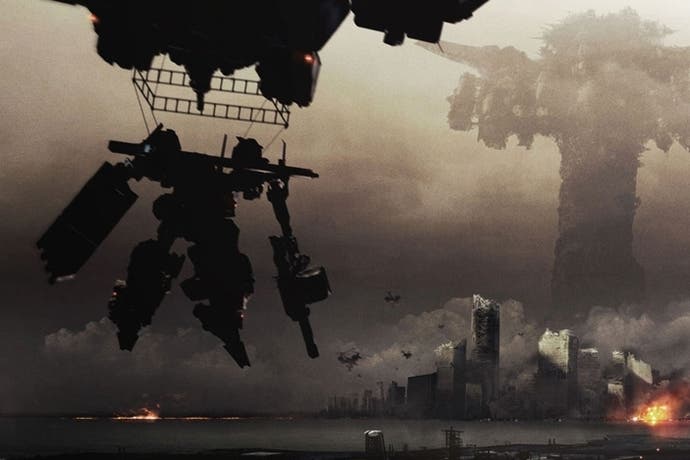Armored Core: Verdict Day review
From Software, with love.
Whenever a numbered Armored Core title rumbles onto the scene, there are two things you can be sure of: the mech combat game will feature more component parts than your average Lego set, and From Software will build upon its core with at least one expanded sequel. (Armored Core 3 was followed by no less than five games that built upon the same engine.) Every game tests the player's piloting and designing skills across one of the most consistently challenging legacies in gaming - and with Armored Core: Verdict Day, the follow-up to last year's Armored Core 5, From shows no signs of going soft.
Much like its predecessor, Verdict Day is a multiplayer-focused game that lets you join a team of fellow mech enthusiasts, build yourself a humanoid tank of improbable proportions and wage war against the competition. But it doesn't forget about those gamers who prefer to sortie alone. The returning Story Mode offers 60 missions that range from the standard AC (Armored Core) face-off to wiping out a turret-packed base, and while the story of renegade AIs and ancient technology feels recycled, series fans will appreciate the knowing nods nonetheless.
While the last game allowed players to access their workshop during a mission, the missions in Verdict Day are noticeably more compact. The fact that you can import your save from Armored Core 5 also means that returning players can brush aside the starter AC (the equivalent of a Kia Rio) for whatever monstrosity they engineered in the last game. This has the potential to dumb down the difficulty, but thanks to a new Hardcore Mode that unlocks after you clear the main campaign, Verdict Day is arguably From Software's most punishing game to date.

Hardcore Mode comes in 10 sadistic variations and is completely separate to the main game. Money Is Everything targets your wallet by increasing repair costs by three times the regular amount. It even charges 50 times as much for ammunition. One-Shot Kill, meanwhile, uses the same effects as Money is Everything while increasing the damage you deal and receive by 10 and five times respectively. Oh, and if you die even once you have to start the whole campaign from the beginning. Suddenly Dark Souls' Ornstein and Smough don't seem quite so intimidating.
As relentless as Armored Core can be, its stern, old-school exterior sits atop a complex and rich framework that's been nurtured over the last 16 years. The 'big robots with big guns' thing isn't for everyone, but for those who've watched the series evolve at a pace that's less radical and more methodical, it's the subtle changes which make all the difference. The sorely missed Weapon Arms, for instance, have been reinstated and include a pair of physical blades and a long-range sniper cannon. They also give bipedal and reverse-joint AC pilots the option to sacrifice some defence for more mobile firepower.
Other tweaks include the return of shields; over 100 new parts that include tanks legs, recon units and the dreaded pile drivers; and a streamlined tuning system that lets you immediately adjust a weapon's stats as opposed to ranking it up through combat. All these elements result in a mech-building process that offers even more depth, and once you've discovered all the hidden parts, amassed a stockpile of credits and unlocked everything that the shop has to offer, there's nothing standing between you and hours of workshop tinkering.

This time, however, constructing the ultimate AC - or even collaborating with other players to build the ultimate AC squad - isn't the only time killer. The new UNAC system lets you create adaptive AIs in a similar style to Armored Core: Formula Front. If that sounds like a fairly complicated process then you're absolutely right, as not only can you program your AI with three separate logic trees that are each governed by seven different categories - including movement, detection and targeting - there are also numerous sub-categories that let you adjust everything from the angle the UNAC approaches the target to the range at which it will use a certain weapon.
Thankfully, the game offers some pre-set AIs that are fairly competent. During the last few missions in particular, I found myself relying on a tank-spec UNAC fitted with a pair of auto-cannons. While this caterpillar-tracked wrecking ball rumbled into the thick of the action, I was able to use the greater mobility of my reverse-jointed AC to keep at an optimal range while slowly depleting my ammo reserves. It's moments like these, where you see all aspects of your piloting and designing skills coming together as one, which make Verdict Day feel a step above its predecessor.
It also ups its game in the improved community focus of the online modes. The old Conquest mode, which worked well in Japan thanks to the volume of players but suffered in the west due to region-specific servers and a small player base, has been superseded by the new World mode. In addition to joining or starting your own team, you now have to choose between three warring factions. At the beginning of a season, each side holds some of the 56 bases and the objective is to capture them all.

Capturing a base works similarly to the last game. A Normal Sortie lets you chip away at a base while a Special Sortie lets you cripple it at an accelerated rate. If another online team isn't present to fight in person then you'll have to tackle turrets, standard enemies or one of the boss-like Unidentified Weapons. The key thing, however, is that the servers appear to be open to all regions outside of Japan; there are Austrian, Swedish, American, Australian, Korean and Chinese teams already on the leaderboards.
This is a huge boon for the non-Japanese Armored Core community as it means that Verdict Day will invariably have more players and so should remain active for far longer. The fact that you can take your UNACs online also means that making up the numbers is less of an issue, and if you're feeling particularly daring, you can even command a team of four UNACs while adjusting their AI behaviour on the fly. The only time the UNACs are excluded is in Free Battle. Here you can fight against other players without concerning yourself with team and faction allegiances.
If Verdict Day has a downside, it's that it sticks to certain aspects of its classic design too rigidly. The AI behaviour of the cannon-fodder enemies is basic at best and the general aesthetic - at least outside of the AC focal point - is bland and garishly angular. It's almost endearing - this is one series where sophisticated gameplay and creative freedom come before flash and narrative - but it wouldn't hurt to tighten things up in other areas.
As it stands, however, Verdict Day is more than just a marked improvement over Armored Core 5. It offers more parts, more maps and new missions while expanding the already tight mechanics with an AI crafting system and an overhauled online mode that encapsulate what Armored Core does best: options, creativity, strategy and teamwork. It's unashamedly hardcore - and all the better for it.

